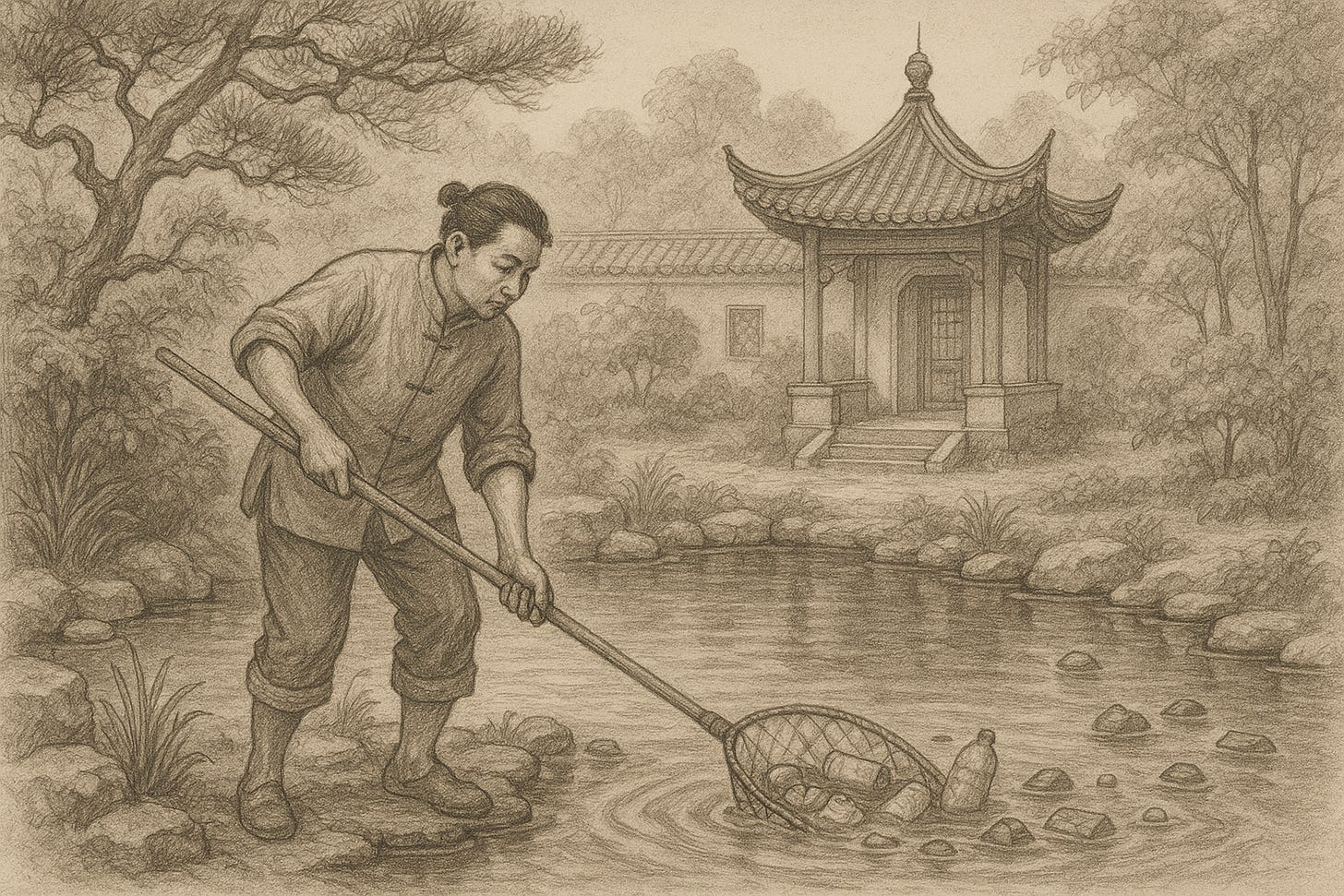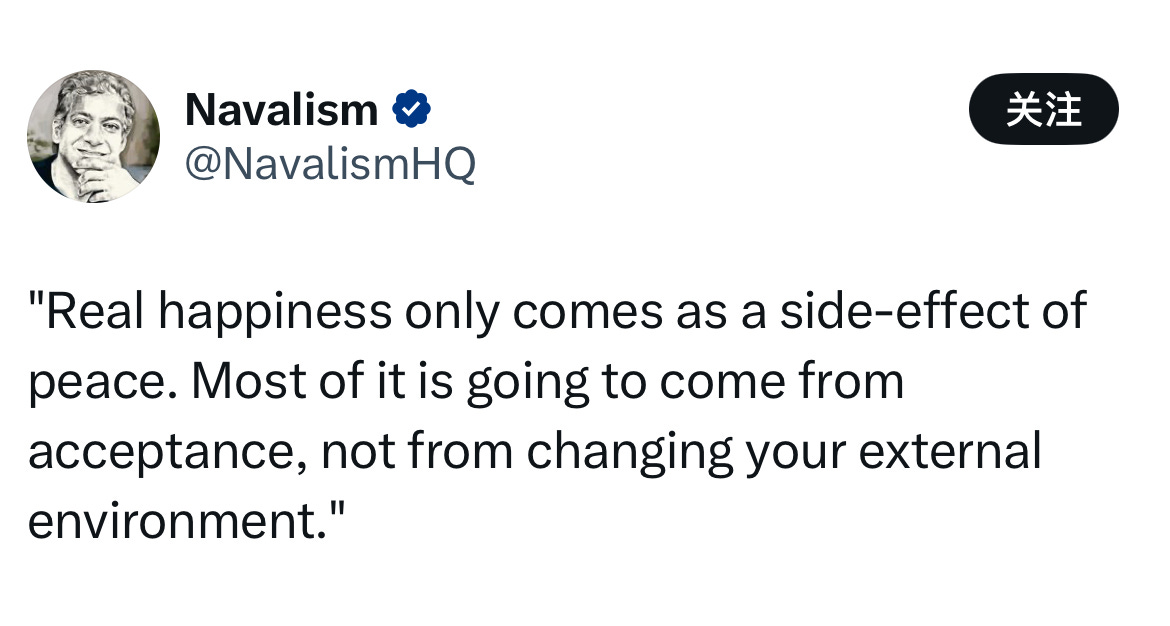How to Move Toward Unconditional Happiness Every Moment of Your Life—Without Renouncing the World
Does happiness that’s independent of conditions even exist,or is it just a myth?
Most of us attach unique conditions to happiness. I used to think I had to make a six-figure income, have European-length vacations, and do a job I loved to death. Others think they need perfect health, a soulmate, or kids who get good grades. The list is infinite.
Personally, I believe only fully enlightened beings can experience happiness entirely independent of conditions like health, wealth, and relationships. But I also believe normal people like you and me can get 99% of the way there—with the right practices and a different attitude toward life.
Don’t want to take it from some random guy on the internet?
Maybe you’d rather believe someone like Naval Ravikant, a financially successful entrepreneur known for his wisdom.
Or maybe you trust spiritual teachers.
Shinzen Young, the creator of the Unified Mindfulness system (under which I’m training to be a coach), defines mindfulness as the cultivation of three attention skills: concentration, sensory clarity, and equanimity. He teaches that as these qualities deepen, a kind of "sensory happiness independent of conditions" naturally arises
You might resonate with someone who bridges both worlds, like Michael A. Singer, a spiritual teacher who sold his software company for approximately $5 billion. He teaches that suffering stems from resisting reality.He encourages surrender and acceptance, letting go of preferences and internal resistance, to find a deep, stable contentment no matter what life throws at you.
Two Ways People Think About Happiness
There are two fundamentally different ways to approach happiness.
The first way: You think happiness is something you earn by matching your life circumstances to an inner standard. Maybe that standard is making six figures, being able to travel around the world, having a job that is your hobby, a hot spouse, or something else.
People who believe this way constantly try to bend their life to meet these standards. But there are two traps. First, life circumstances change; you might get laid off from that six-figure job or burn out. Second, the inner standard changes. When you finally hit one goal, a new, higher one takes its place, and suddenly what you have isn’t enough anymore.
That’s why this approach often feels like a never-ending rat race.
The second way: You believe happiness is your default state. It’s like gold buried under layers of coal, you can’t even see the shine, but it’s still there.
From the outside, these people might still work toward goals, but their intention is different. They use life events as opportunities to dig away the coal so their intrinsic happiness can shine.
Can you see the distinction now? The first way is all about doing to compensate for lack. The second way is all about undoing to reveal intrinsic well-being.
Same Pain, Opposite Responses
Both types of people experience unhappiness. It comes the same way for everyone through unpleasant sensations in the body (what we call “emotions”) and negative thoughts. Sometimes it’s boredom. Sometimes it’s anger or depression.
The difference is how they respond.
The first type tends to suppress the feelings or escape them through partying, substances, TikTok binges, or anything to avoid the pain because they can’t instantly change their circumstances to match the inner standards. Some go a step further, becoming self-help workaholics. They think, “If I just grind harder and improve my life conditions enough, I’ll escape this pain.”
The second type experiences the same pain, but they understand where it’s coming from.
Eckhart Tolle describes a “pain-body,” an energy field of stored emotional pain. When triggered by an external event (say, someone criticizes you), it “wakes up,” hijacks your thoughts, and feeds on your reactivity.
The event doesn’t create the pain, it simply triggers pain that was already inside you.
If the person criticized has little stored pain, they don’t get triggered. They can calmly evaluate the feedback, take what’s true, and dismiss what’s false. Even if the criticism comes in an angry tone, they won’t react with anger, they might even feel compassion, thinking,Wow, this person must be having a rough day.
Want proof? Ask any parent how they feel when their child throws a tantrum. Some snap. Some just feel love and compassion for their child.
How Pain Gets Stored
Every experience has a pleasant or unpleasant quality. For example, being bullied as a kid is unpleasant. Not knowing how to handle the pain, we suppress it—we push it into the subconscious.
Over the years, all the pain we push away aggregates into a pain body—a collection of painful feelings and thoughts.
But suppression is not elimination. If you don't handle it, it will always be there. Imagine throwing garbage into a pond. At first, you don’t see the trash, but over time, the pond starts to smell.
That smell? That’s the random, “no apparent reason” unpleasant feelings we get in daily life.
The pain-body is triggered by events, but it also naturally releases bits of pain on its own. That release shows up as random stress or discomfort. Why? Because our deeper self wants to heal. These old energies surface so they can be released.
The second type of person knows there’s only one solution: let the garbage surface. When it comes up, it stinks even worse for a while—but then it can finally be removed.
Happiness Is a Numbers Game
Once you understand that the skill of happiness is about releasing pent-up pain-body energy, happiness becomes a numbers game.
The more effectively you release that stored energy, the happier you become—independent of conditions.
And you’ll see why some people meditate for years or go to churches every week but don’t get much happier. They release some pain in their practice, but back in daily life they suppress their feelings, vent on loved ones, or chase achievements to “offset” the pain inside.
The Wise Way
The wise way is simple. Either release as much pain as possible—or sharpen the skills that make releasing more effective—in every moment of your life.
When you fully feel uncomfortable feelings with radical acceptance, you’re releasing. When you practice mindfulness, you’re building the muscles of release.
When you do this consistently, you move toward unconditional happiness every single day because more and more trash in the pond is removed.
Practice doesn’t mean sitting cross-legged all day. It means integrating practice into your daily life. It’s a devotion—not necessarily to a religious figure, but to the practice itself.
Each present moment stops being just a stepping stone to something “better.” Each moment becomes a practice opportunity. When you treat it this way, you naturally become present, and when you’re present, your whole relationship to life changes.
By practicing everywhere all the time, the “temple” comes to you. That’s why you don’t need to renounce the world. Life itself becomes your temple.
Practicing in Every State
There are only three states of mind you’ll meet in daily life: neutral, unpleasant, pleasant. Each is a chance to practice.
In neutral moments: Practice mindfulness. Focus on your breath or do a body scan. Every rep strengthens the three core mindfulness skills—concentration, sensory clarity, and equanimity. These skills not only raise your baseline happiness, they also make future releases more effective.
You can also practice gratitude. Generate good feelings and focus on how they feel in your body. You’re not just “thinking positively”; you’re tuning into the coal covered gold of intrinsic well-being.
If you want to grow faster, you can even recall unresolved memories to release them intentionally—turning neutral moments into “training sessions,” like lifting weights at the gym.
In unpleasant moments: Don’t escape, suppress, or frantically “fix” your outer life just to avoid the feeling. Unpleasant moments can be triggered by events, arise spontaneously, or come from your own intentional recall.
Whatever their source, surrender and relax. Apply mindfulness to the raw experience. Notice the negative words in your mind, the images that appear. And most importantly, feel the sensations in your body with zero resistance, and let go the intention to control it in any way.
Just remember: observing pain with acceptance releases the energy behind the pain.
If it gets too intense, you can anchor your attention on neutral sights or sounds outside while maintaining a background acceptance of the feelings inside. You’re still releasing.
You are picking up trash from the pond of your subconscious. The trash is sticky and smells terrible; that’s just the price you need to pay to be lighter, happier, and freer.
In pleasant moments: Simply enjoy. Pour your attention onto the good feelings in your body. Instead of letting worry dominate the foreground of your mind and happiness hum quietly in the background, reverse them.
I once caught myself worrying about something—but noticed I was smiling at my son. I shifted my attention to the smile, to the warmth around my face. That moment told my mind:I honor the positive.
A Friendly Reminder
Trying to improve your life circumstances doesn’t contradict this practice. Build the business. Find the job you love. But don’t fall for the illusion that changing conditions is the ultimate solution.
True happiness grows from within when you are willing to handle the pain you have pushed away. When you see your whole life as practice, the temple is no longer somewhere you have to go. The temple is already here, right where you are—in this moment.



